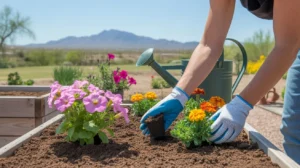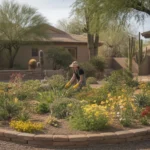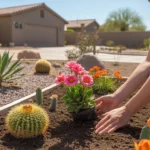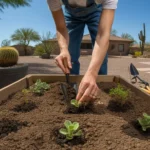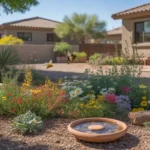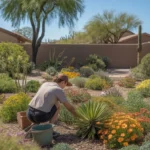Spring is the perfect time to start a garden in Mesa and across the Southwest desert. With longer days and warmer temperatures, plants are eager to burst into life. But if you’re new to gardening in this unique climate, it can feel a bit daunting. These essential spring gardening tips will help beginner gardeners in Mesa get growing with confidence.
Choose Desert-Adapted Plants
One of the keys to successful gardening in Mesa is selecting plants that can handle the intense heat and dry conditions of the Southwest desert. Many popular garden plants struggle in this climate, leading to disappointment for novice gardeners.
Instead, focus on native and desert-adapted plants that are well-suited to the Sonoran desert. Some great options for spring planting include:
- Desert marigold
- Penstemons
- Globe mallow
- Chuparosa
- Desert milkweed
- Salvias
These tough plants can handle the heat and provide beautiful color with minimal water and care. As you gain experience, you can experiment with more diverse plant selections. But starting with desert-proven varieties is a smart way for beginners to achieve early success.
Get the Timing Right
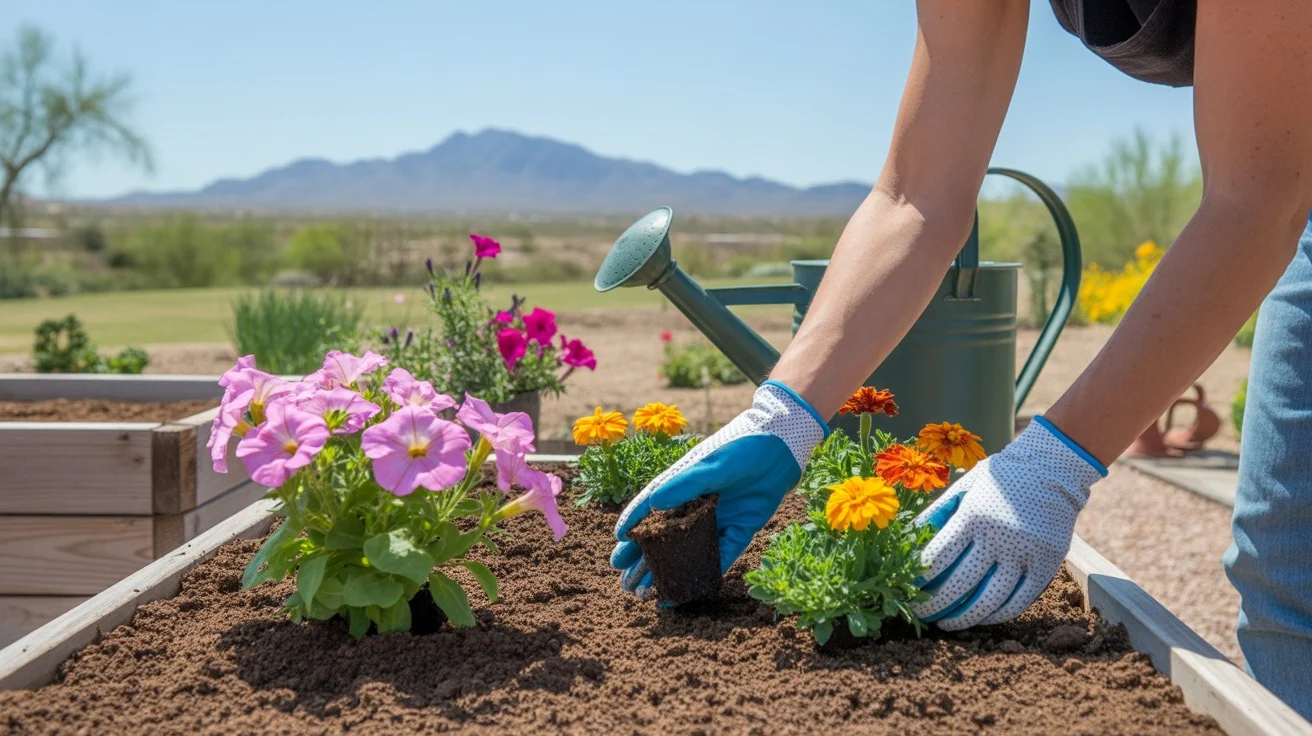
In places like the Midwest or Northeast, the spring planting window is short and clearly defined by the last frost date. But in Mesa, our spring growing season is more nuanced. Many plants can go in the ground as early as February, taking advantage of the mild late winter weather to get established.
For beginners, a good rule of thumb is to plant hardy, cool-season annuals like pansies, violas, and snapdragons in February or early March. Wait until mid-March or early April to plant more tender, warm-season flowers like zinnias, marigolds, and vinca.
Vegetables have their own ideal planting windows. Cool-season crops like lettuce, peas, carrots and beets can usually be direct seeded in February or March. Warm-season vegetables like tomatoes and peppers should wait until early April to avoid any late cold snaps. Planting at the right time helps ensure your new garden gets off to a strong start.
Prepare Your Soil
Mesa’s desert soils are lean and low in organic matter. While native plants are adapted to these conditions, most garden and landscape plants benefit from soil improvements. Before planting, work a 2-3 inch layer of compost or well-aged manure into the top 6-12 inches of soil. This will improve the soil structure, drainage, and nutrient content.
In raised beds or containers, consider using a high-quality potting mix formulated for the Southwest. Regular potting soil dries out too quickly in Mesa’s intense spring heat. Look for mixes that contain ingredients like coir, vermiculite or perlite to improve moisture retention without getting soggy.
If you’re not sure about your soil quality, do a simple soil test before planting. Kits are available from the University of Arizona Extension or local nurseries. The results will guide any soil amendments needed to optimize plant health and performance.
Water Wisely
Spring is Mesa’s dry season, with minimal rainfall and low humidity. While the mild temperatures are great for planting, consistent watering is critical to help new plants get established. Most plants need to be watered deeply and regularly until their roots grow out into the surrounding soil.
For beginners, the easiest approach is usually a simple drip irrigation system connected to an automatic timer. Avoid relying on overhead sprinklers, which lose a lot of water to evaporation and wind drift. Drip tubing or emitters apply the water at the soil surface right where the plant needs it.
The watering frequency depends on the plant type, soil and weather conditions. A good starting point is to water desert-adapted plants every 3-4 days, and high-water plants every 1-2 days. Let the top inch of soil dry out between waterings to avoid oversaturating the roots. As plants mature, you can gradually cut back the watering frequency to encourage deep, drought-tolerant roots.
Mulch to Conserve Moisture
Along with proper irrigation, mulching is one of the best things beginning gardeners can do to conserve precious moisture in Mesa’s dry spring climate. A 2-3 inch layer of organic mulch like shredded bark, wood chips or straw helps to:
- Slow evaporation from the soil surface
- Moderate soil temperature fluctuations
- Suppress weed growth
- Reduce soil compaction
Avoid mounding mulch against plant stems or tree trunks, which can lead to rot or disease. Gravel and rock mulches are popular in the Southwest, but they can get very hot in the sun and reflect a lot of heat onto plants. For most plantings, natural materials are a better choice.
Consistent mulching is one of the practices that separates successful Mesa gardens from those that struggle. Get in the habit of refreshing the mulch layer each spring before the heat arrives for best results.
Provide Shade and Wind Protection
Spring weather in Mesa can be intense, with strong winds and punishing sun even before summer hits. Tender new plantings often need extra protection to avoid damage while they’re getting established.
Shade cloth stretched over hoops or frames is an easy way to shelter sensitive plants from direct sun. Look for knitted shade fabrics that block 30-50% of sunlight – more than that can impede healthy growth.
In windy areas, staking or support is important to keep new plants from being uprooted or damaged. Tall flowers and vegetables can be tied to individual stakes, or enclosed in simple wire cages. Barriers made from straw bales or stacked cinderblocks can shield beds from drying winds while adding a rustic design element.
Stay on Top of Weeds
Spring weeds can quickly overwhelm new gardens in Mesa if allowed to get out of hand. Invasive species like stinknet and buffelgrass grow vigorously in spring, going from seed to flower in a matter of weeks.
Regular weeding is essential to keep these competitors under control. For beginners, a simple approach is to use a hoe or cultivator to cut down weed seedlings while they’re still small. Avoid deep tilling, which can bring even more weed seeds to the surface.
Weed barrier fabrics are popular, but they have some drawbacks in Mesa’s climate. The fabric can heat up the soil and impede water infiltration if not installed properly. Thick layers of organic mulch often work just as well without these issues.
If you stay diligent through spring, the arrival of hot summer weather will naturally knock back many annual weeds. Perennial weeds may need repeated removal or spot treatment with herbicide to fully eradicate.
Watch for Signs of Trouble
Beginning gardeners often struggle to identify issues before they become serious problems. In Mesa’s spring climate, a few common things to watch for include:
- Sunburn: Pale or bleached leaves indicate a plant is getting too much direct sun. Provide temporary shade or relocate to a more protected spot.
- Wilting: Plants that regularly wilt in the afternoon heat may need more frequent watering. Check soil moisture levels and adjust irrigation as needed.
- Yellowing: Yellowing leaves are often a sign of nutrient deficiency or improper watering. Make sure plants are getting consistent moisture and consider a slow-release fertilizer.
- Insects: Spring pests like aphids, whiteflies and thrips can quickly damage new growth. Check plants regularly and treat early with insecticidal soaps or horticultural oils.
When in doubt, ask for help. Local nurseries, Extension services, and gardening groups are great resources for diagnosing problems and recommending solutions. Catching issues early is key to keeping your new garden healthy and thriving.
Keep Learning and Experimenting
Gardening in Mesa’s unique Southwestern climate takes time and practice to master. Even experienced gardeners are always learning and adapting their approaches. As a beginner, focus on the fundamentals and don’t be afraid to experiment.
Some plants will thrive while others struggle, even with attentive care. Treat every challenge as a chance to learn and refine your techniques. Before long, you’ll develop a repertoire of reliable crops and practices that work in your particular yard and soil.
Above all, have fun! Spring is a magical time to be outdoors in Mesa, with mild weather and new life emerging all around. Pause regularly to enjoy the fruits of your labor, whether that’s a juicy homegrown tomato or a vibrant patch of wildflowers. With patience and persistence, you’ll soon be reaping the many rewards of a successful desert garden.

